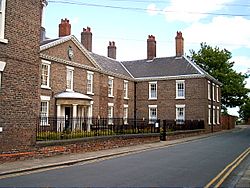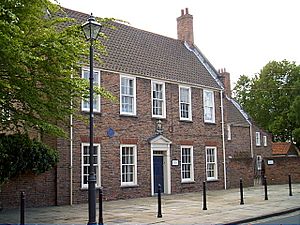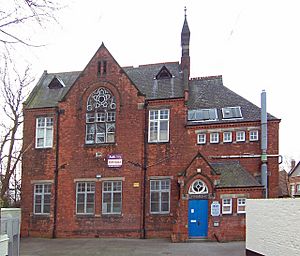Charterhouse, Kingston upon Hull facts for kids

The Charterhouse (built c. 1780)
|
|
| Monastery information | |
|---|---|
| Full name | Hull Charterhouse |
| Order | Carthusian |
| Established | 1377 |
| Disestablished | 1538 |
| Dedicated to | Saint Michael |
| Site | |
| Location | Kingston upon Hull, England |
The Charterhouse (also known as Hull Charterhouse) was once a Carthusian monastery and a special type of home called an almshouse. It is located in Kingston upon Hull, England. This important building was built just outside the old town walls.
The almshouse part of the Charterhouse survived when many monasteries were closed down in England. However, the monastery itself was destroyed in 1538. Later, the almshouse building was also taken down before the first siege of Hull during the English Civil War. A new building was put up in 1645. This was replaced again in 1780. Today, the buildings still work as an almshouse with a small chapel. They have been used for this purpose for a very long time, even up to 2012.
The area around the Charterhouse, which is about 1.65 hectares (or 4 acres), became a special conservation area in 1975. This area also includes a Victorian school called Charterhouse School and a burial ground from the 1700s.
History of the Charterhouse
Records from 1796 suggest there might have been a religious building at the Charterhouse site since the time of King Edward I.
We know for sure that the land became the property of William de la Pole in the 1300s. Around 1350, he started a hospital there, which was called the Maison Dieu. At one point, 13 men and 2 women lived there, along with 6 priests.
William de la Pole wanted to build a monastery for a group called the Poor Clares. He even got permission from King Edward III. But he passed away before he could finish it. His son, Michael de la Pole, completed the monastery in 1377. It was dedicated to Saint Michael and was home to 13 monks from the Carthusian Order.
The monastery had a good income in 1535. It was not immediately closed down when King Henry VIII started closing monasteries. It even got special permission to continue. However, it was eventually closed in 1538, and the monastery buildings were destroyed.
The hospital part of the Charterhouse was given to the King in 1506. But in 1553, it was given back to the mayor and people of Hull. After this, the hospital became known as the Charterhouse, named after the former monastery.
During the English Civil War, the hospital building was pulled down. This happened before the First Siege of Hull in 1642. It was done to stop the attacking forces from using it. A new building was put up in 1645, costing £474. More rooms and a chapel were added between 1663 and 1673.
The building was rebuilt again in 1780 and made bigger in 1803. By the 1860s, the hospital looked after 70 elderly people, giving each a weekly allowance.
The Master's House, which is part of the Charterhouse, is thought to include parts of the 1650 hospital. It was damaged during the Second World War but was fixed in 1950. Both the Charterhouse and the Master's House are important historic buildings. As of 2002, the Charterhouse still works as an almshouse.
Charterhouse School
The Charterhouse School is located near the main Charterhouse building. It is a Victorian school built in 1881. It was designed by an architect named William Botterill.
The school building has a single-story part for younger children. There is also a two-story part that used to have separate entrances for boys and girls. The girls' classrooms were on the first floor. In 1950, it became a secondary school.
In 1967, the school became part of Hull College. By 2015, the college had sold the school site.



